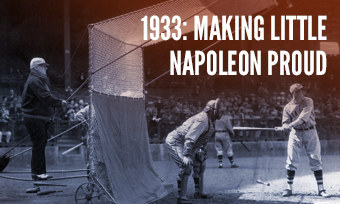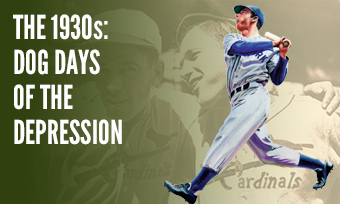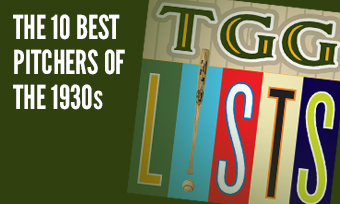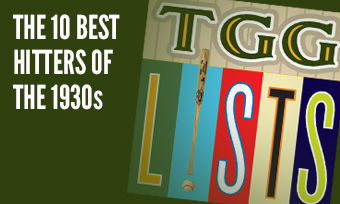The Yearly Reader
Leaders and Honors, 1933
Our list of baseball’s top 10 hitters and pitchers in both the American League and National League for the 1933 baseball season, as well as the awards and honors given to the game’s top achievers of the year.
The National League’s Top 10 Hitters, 1933
Bold type in brick red indicates league leader.
1. Chuck Klein, Philadelphia
Key Numbers: .368 average, 101 runs, 223 hits, 44 doubles, 7 triples, 28 home runs, 120 RBIs, 56 walks, 15 stolen bases, .422 on-base percentage, .602 slugging percentage.
One of two triple crown winners based at Philadelphia in 1933, Klein continued to embrace Baker Bowl (where he hit a career-high .467) as his best friend and plowed over the 200-hit mark for the fifth straight year. How did the Phillies reward him? By trading him to the Cubs for $65,000 and three common players.
2. Wally Berger, Boston
Key Numbers: .313 average, 37 doubles, 8 triples, 27 home runs, 106 RBIs, 77 strikeouts.
As it had been since 1930, Berger continued to account for roughly half of the Braves’ home runs.
3. Pepper Martin, St. Louis
Key Numbers: .316 average, 122 runs, 189 hits, 36 doubles, 12 triples, 8 home runs, 57 RBIs, 67 walks, 26 stolen bases.
For one of the few times in his career, Martin lived up to the expectations pinned upon him after his unforgettable work at the 1931 World Series.
4. Arky Vaughan, Pittsburgh
Key Numbers: .314 average, 29 doubles, 19 triples, 9 home runs, 97 RBIs, 64 walks, 12 intentional walks.
The sophomore shortstop was intent on becoming Honus Wagner resurrected—and so were the Bucs, who brought the Pirates legend in to mentor and room with him.
5. Babe Herman, Cincinnati
Key Numbers: .289 average, 36 doubles, 12 triples, 16 home runs, 93 RBIs.
Herman’s cycle on the season’s penultimate day gave the majors eight such achievements for the year—setting the record for the most in one season (equaled in 2009). He also had the NL’s only 3-homer game of the year.
6. Mel Ott, New York
Key Numbers: .283 average, 98 runs, 36 doubles, 23 home runs, 103 RBIs, 75 walks.
Though going through one of the more statistically mild campaigns of his career, Ott was still feared enough that in one game (September 1 at Boston) he went 0-for-0—with five walks.
7. Paul Waner, Pittsburgh
Key Numbers: 154 games, .309 average, 101 runs, 191 hits, 38 doubles, 16 triples, 7 home runs, 70 RBIs.
Now in his eighth year, Waner had all but secured the title as the NL equivalent of Charlie Gehringer, putting forward “Mechanical Man” numbers.
8. Joe Medwick, St. Louis
Key Numbers: .306 average, 92 runs, 182 hits, 40 doubles, 10 triples, 18 home runs, 98 RBIs.
In his first full season at the major-league level, the 21-year-old Medwick proved that his late-season audition of the year before (.349 in 26 games) was no fluke.
9. Ripper Collins, St. Louis
Key Numbers: 132 games, .310 average, 26 doubles, 7 triples, 10 home runs, 68 RBIs.
The switch-hitter strangely hit only one of his 10 home runs at typically live Sportsman’s Park—but it was all just a warm-up for what he had in store a year later.
10. Chick Fullis, Philadelphia
Key Numbers: .309 average, 647 at-bats, 91 runs, 200 hits, 31 doubles, 6 triples, 18 stolen bases.
No, not Chick-fil-A, but the part-time outfielder who was given a rare chance to play every day, rewarding the Phillies with an excellent showing from the leadoff spot.
The American League’s Top 10 Hitters, 1933
1. Jimmie Foxx, Philadelphia
Key Numbers: .356 average, 125 runs, 204 hits, 37 doubles, 9 triples, 48 home runs, 163 RBIs, 96 walks, 9 intentional walks, 93 strikeouts, .703 slugging percentage.
Double-X matched Chuck Klein down the street with a Triple Crown effort, getting many of his numbers in bunches; he hit three homers in one game, four in a doubleheader, and hit for the cycle, knocking in nine runs. All this, and his second straight MVP—and he got a slight pay cut in salary.
2. Lou Gehrig, New York
Key Numbers: .334 average, 138 runs, 198 hits, 41 doubles, 12 triples, 32 home runs, 139 RBIs, 92 walks.
Another superb year for the Iron Horse was sweetened at the end of the year with his marriage to Eleanor Twitchell.
3. Babe Ruth, New York
Key Numbers: 137 games, .301 average, 97 runs, 34 home runs, 103 RBIs, 114 walks.
A seven-year streak of 40-plus home runs came to an end, but Ruth remained remarkably potent at age 38.
4. Charlie Gehringer, Detroit
Key Numbers: 155 games, .325 average, 103 runs, 204 hits, 42 doubles, 6 triples, 12 home runs, 105 RBIs, 68 walks.
Gehringer managed to co-lead the team in home runs with rookie Hank Greenberg; that wasn’t going to happen again, given Greenberg’s eventual power surge.
5. Mickey Cochrane, Philadelphia
Key Numbers: 130 games, .322 average, 104 runs, 30 doubles, 15 home runs, 60 RBIs, 106 walks, .459 on-base percentage.
Cochrane hit for the cycle for the second straight season, thus becoming the only catcher to do it more than once.
6. Joe Cronin, Washington
Key Numbers: .309 average, 89 runs, 186 hits, 45 doubles, 11 triples, 5 home runs, 118 RBIs, 87 walks.
While leading the Senators to the World Series in his first year of managing, Cronin still found enough concentration to remain a top AL hitter.
7. Heinie Manush, Washington
Key Numbers: .336 average, 115 runs, 221 hits, 32 doubles, 17 triples, 5 home runs, 95 RBIs.
Manush fashioned together the season’s two longest hitting streaks—including a 33-game run unsurpassed in Senators/Twins history.
8. Bob Johnson, Philadelphia
Key Numbers: .290 average, 103 runs, 44 doubles, 21 home runs, 93 RBIs, 85 walks.
After a pair of star seasons with Portland in the Pacific Coast League, Johnson began a terrific but almost anonymous (particularly in historical terms) career; maybe he’d be better remembered if his name wasn’t so generic.
9. Tony Lazzeri, New York
Key Numbers: .294 average, 94 runs, 22 doubles, 12 triples, 18 home runs, 104 RBIs, 73 walks, 15 stolen bases.
Lazzeri matched his career high in home runs for the third time; he denied himself a chance to break it when given permission to skip out on the Yankees’ final eight games to head back home to San Francisco.
10. Al Simmons, Chicago
Key Numbers: .331 average, 85 runs, 200 hits, 29 doubles, 10 triples, 14 home runs, 119 RBIs.
Sent to Chicago as the first clearance item in Connie Mack’s second fire sale at Philadelphia, Simmons equaled Chuck Klein by earning 200 hits over five straight seasons.
The National League’s Top 10 Pitchers, 1933
1. Carl Hubbell, New York
Key Numbers: 1.66 ERA, 23 wins, 12 losses, 5 saves, 45 appearances, 33 starts, 10 shutouts, 308.2 innings, 47 walks.
Carl Hubbell wasn’t great because he could be, but because he had to be; five of his victories were by scores of 1-0—including his epic 18-inning shutout of the Cardinals on July 2.
2. Lon Warneke, Chicago
Key Numbers: 2.00 ERA, 18 wins, 13 losses, 36 appearances, 34 starts, 26 complete games, 287.1 innings.
The young right-hander lowered his ERA from his league-leading figure of the year before, but failed to get a second straight crown thanks to Hubbell. His own hitting helped his cause; he batted .300 for the Cubs over 100 at-bats, and actually rapped the first triple in All-Star Game history.
3. Hal Schumacher, New York
Key Numbers: 2.16 ERA, 19 wins, 12 losses, 7 shutouts, 258.2 innings, 36 grounded into double plays.
In his breakout campaign, Schumacher used an overhand sinker to induce a multitude of grounders—many of which were turned into double plays. He missed out on a chance to give the Giants two 20-game winners when he lost his final start at home against the lowly Phillies.
4. Ed Brandt, Boston
Key Numbers: 2.60 ERA, 18 wins, 14 losses, 41 appearances, 32 starts, 4 shutouts, 287.2 innings.
The left-hander in the midst of a solid four-year run with the Braves could make the claim that he was the NL’s second-best lefty, after Hubbell.
5. Dizzy Dean, St. Louis
Key Numbers: 3.04 ERA, 20 wins, 18 losses, 48 appearances, 34 starts, 26 complete games, 293 innings, 64 walks, 199 strikeouts.
Still trying to make his record look good in spite of a terrific ERA, Dean became the first modern pitcher to strike out 17 in a game.
6. Larry French, Pittsburgh
Key Numbers: 2.72 ERA, 18 wins, 13 losses, 47 appearances, 35 starts, 291.1 innings, 55 walks.
Hubbell may have made headlines with his screwball success in 1933, but French used the same pitch to keep everyone happy in Pittsburgh with his continued, effective workhorse ethic.
7. Ben Cantwell, Boston
Key Numbers: 2.62 ERA, 20 wins, 10 losses, .667 win percentage, 40 appearances, 29 starts, 254.2 innings, 54 walks.
Perennial loser Cantwell (56-98 over previous 10 years) sprang to life and became the Braves’ first 20-game winner since 1921, in their first winning season since…1921.
8. Huck Betts, Boston
Key Numbers: 2.79 ERA, 11 wins, 11 losses, 242 innings, 55 walks.
The veteran right-hander produced a virtual carbon copy of his 1932 effort, though it would have been nice if the Braves didn’t give him almost a full run less of support per start than the year before.
9. Van Lingle Mungo, Brooklyn
Key Numbers: 2.72 ERA, 16 wins, 15 losses, 41 appearances, 28 starts, 248 innings.
Just saying his name is fun enough—the “Lingle” is the rare case of a newborn being given his mother’s maiden name for a middle moniker—but his blistering fastball and colorful Carolina charm also made him fun for Brooklyn fans to watch.
10. Guy Bush, Chicago
Key Numbers: 2.75 ERA, 20 wins, 12 losses, 41 appearances, 32 starts, 4 shutouts, 259 innings.
A year after just missing out on his first 20-win campaign, Bush clinched the milestone for the only time in his career by outdueling Dizzy Dean in his last start of the season.
The American League’s Top 10 Pitchers, 1933
1. Mel Harder, Cleveland
Key Numbers: 2.95 ERA, 15 wins, 17 losses, 43 appearances, 31 starts, 253 innings.
Harder found it just that trying to win games, his AL-best ERA spoiled by an Indians offense struggling to adjust to the distant fences at monstrous Cleveland Stadium.
2. Lefty Grove, Philadelphia
Key Numbers: 3.20 ERA, 24 wins, 8 losses, .750 win percentage, 6 saves, 45 appearances, 28 starts, 21 complete games, 275.1 innings.
Grove put the finishing touches on a six-year domination (152 wins, 41 losses) within the AL.
3. Firpo Marberry, Detroit
Key Numbers: 3.29 ERA, 16 wins, 11 losses, 37 appearances, 32 starts, 238.1 innings.
Best known for closing out games throughout his career, Marberry arrived in Detroit after 10 years with the Senators and became as full-time a starter as he would be, proving he could be superior rotation material.
4. Earl Whitehill, Washington
Key Numbers: 3.33 ERA, 22 wins, 8 losses, .733 win percentage, 39 appearances, 37 starts, 19 complete games, 270 innings.
Amid a steady career full of .500 pitching and standard ERAs, Whitehill—the guy sent from Detroit to D.C. in exchange for Marberry—enjoyed his one summer of content.
5. Tommy Bridges, Detroit
Key Numbers: 3.09 ERA, 14 wins, 12 losses, 233 innings, 6 hit-by-pitches.
Among Bridges’ 14 wins were two one-hitters—with the lone hits coming in the eighth inning of each.
6. General Crowder, Washington
Key Numbers: 3.97 ERA, 24 wins, 15 losses, 52 appearances, 35 starts, 299.1 innings.
Crowder led the roll call for the Senators and, three years later, still had the Browns kicking themselves for sending him to Washington for Goose Goslin—who, by the way, was back with the Senators in 1933.
7. Monte Weaver, Washington
Key Numbers: 3.25 ERA, 10 wins, 5 losses, 152.1 innings.
Bouncing off a 22-win campaign the year before, Weaver was stiffened up by a sore shoulder—but recovered with a terrific late-season run to help lift the Senators over the top toward the AL pennant. No wonder, at the time, that the Yankees wanted him in exchange for Red Ruffing.
8. Clint Brown, Cleveland
Key Numbers: 3.41 ERA, 11 wins, 12 losses, 185 innings, 34 walks.
Like Mel Harder above, Brown put together some nice sabermetrics thanks to life at Cleveland Stadium (where he was 8-5 with a 2.17 ERA)—but it didn’t translate into a nice record overall.
9. Bump Hadley, St. Louis
Key Numbers: 3.92 ERA, 15 wins, 20 losses, 45 appearances, 36 starts, 19 complete games, 316.2 innings, 141 walks.
Leading the league in almost everything accumulative, workhorse Hadley had the upper hand on triple crown guy Jimmie Foxx, having him go 0-5 with 4 Ks on September 16.
10. Lefty Gomez, New York
Key Numbers: 3.18 ERA, 16 wins, 10 losses, 234.2 innings, 163 strikeouts.
Gomez’s ERA was easily the best on a Yankee staff that likely cost the team a shot at the pennant.









